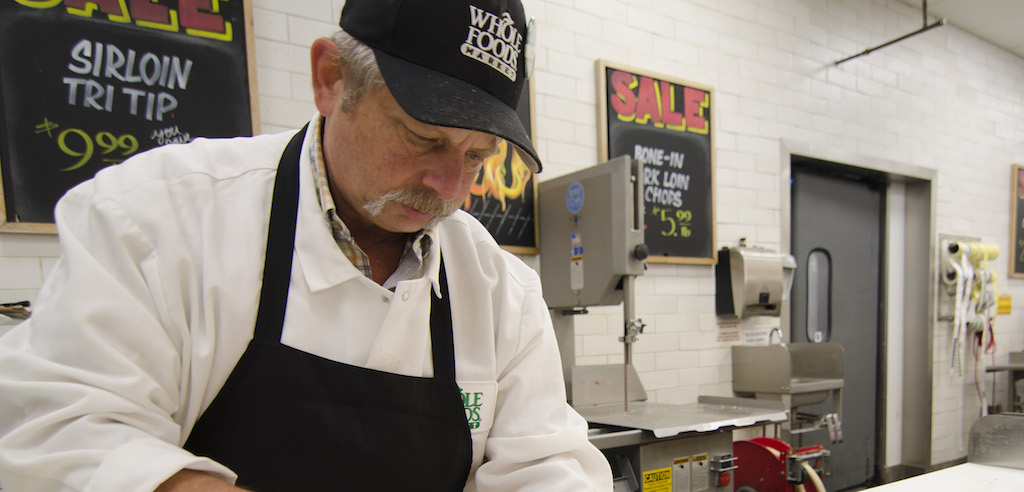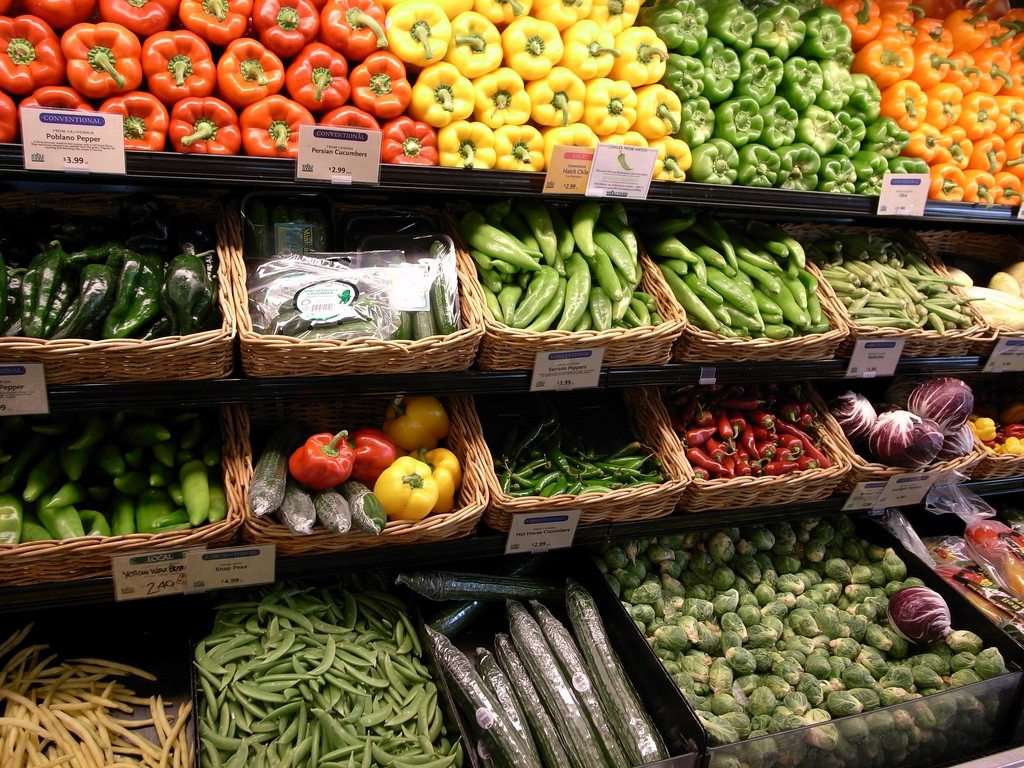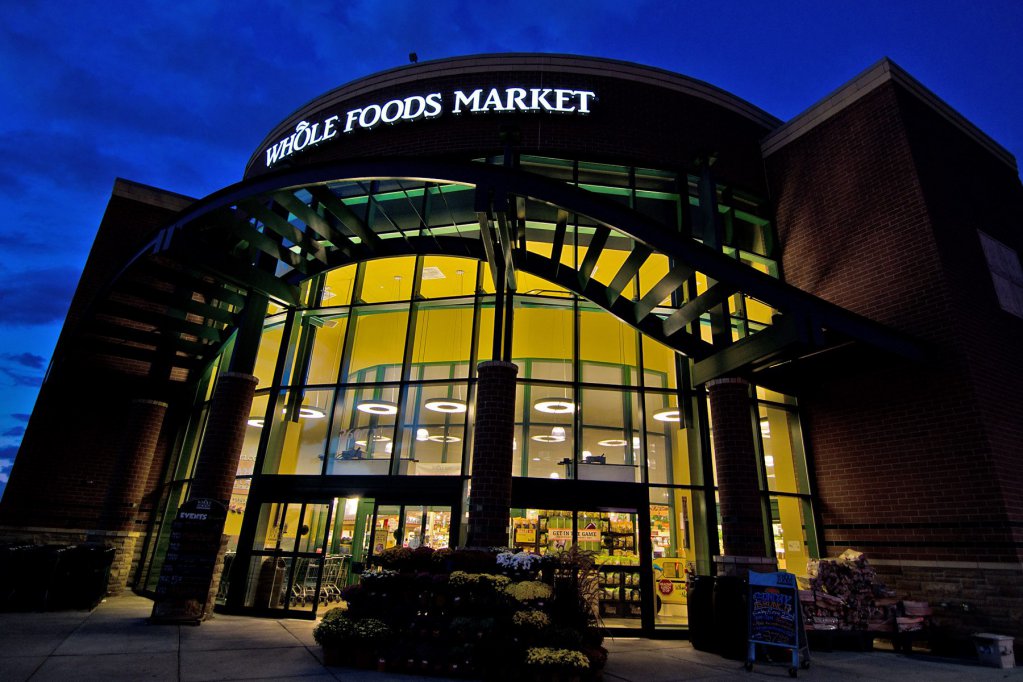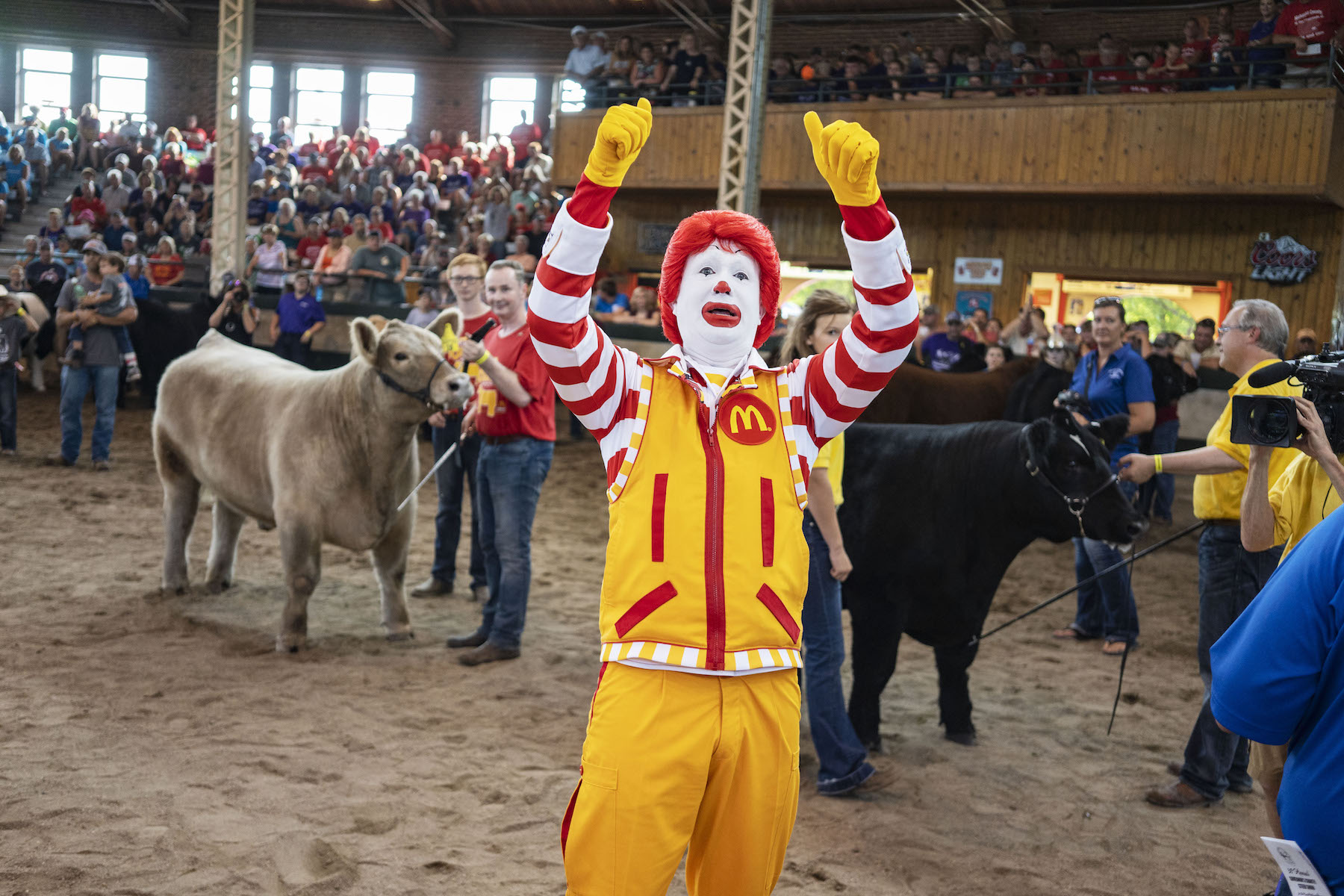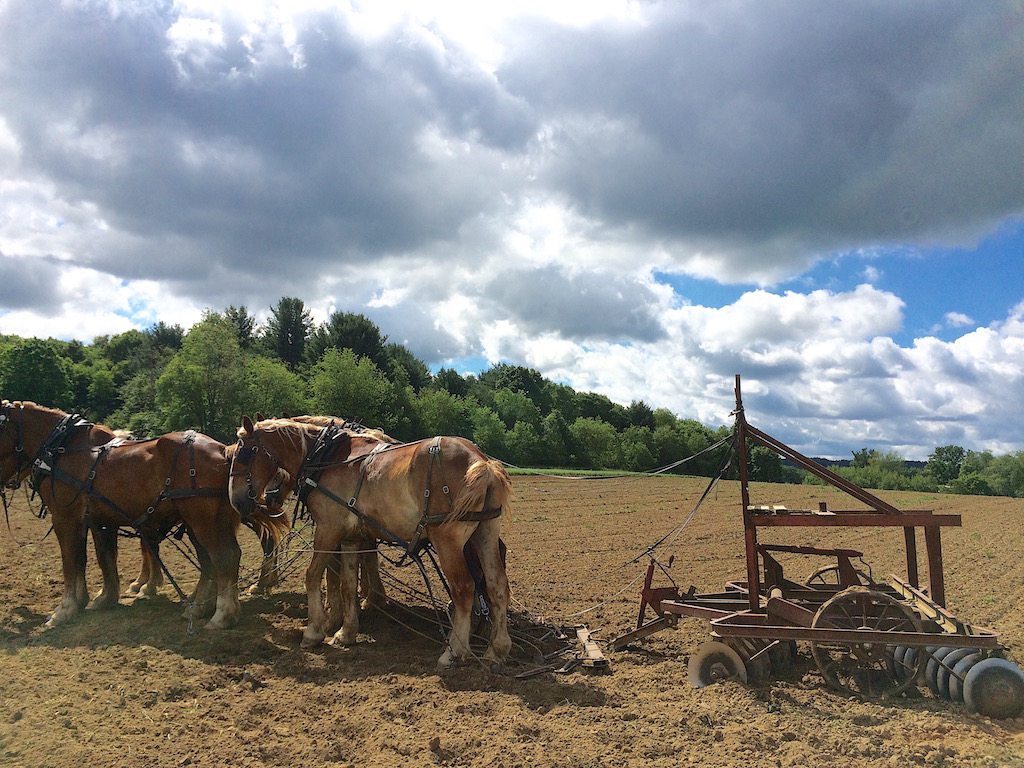
Karen Gardner
Across Pennsylvania, Amish farming communities are differentiated from their neighbors by technological abstention. The members of the Clarion County Amish community are no exception. They do not own phones, and do not operate computers or motor vehicles. And yet, these same farmers are adapting, collaborating with their non-Amish neighbors to stay competitive in a food marketplace increasingly defined by technological advancement and centralization.
As is the case in most of Pennsylvania, Clarion County is not considered an ideal place to build large farms: Plots often run smaller in the hilly, rugged high plains of the Appalachian Plateaus. And while Pittsburgh (two hours south of Clarion County) attracts jobs and capital, this part of Western Pennsylvania is quiet, with few people and fewer jobs. So not too many English people (as the Amish refer to the non-Amish) grow vegetables in Clarion County. Says Aaron Schwartz, an Amish farmer in this community: “They’d have to build a road first.”
Schwartz was one the founding farmers of the Clarion River Organics growers’ cooperative. In 2000, after leaving a community in Indiana and then living for a while in Ontario, Canada, he and his family (he has 15 children and 40 grandchildren) moved to Clarion County with four other Amish families. They centered their new community around growing organic produce, and family members work at home or on their family farms as much as possible.
 Karen Gardner
Karen Gardner Clarion County, Pennsylvania
I met Schwartz on a sunny morning in late June. He was “discing”—or fine tuning—the soil in part of his field to plant buckwheat, a cover crop that helps build soil fertility. As he stepped down from the disc, which churns and loosens the soil, his six horses stood patiently waiting. Schwartz wore a simple black hat, a shirt fashioned with hooks rather than buttons, and black pants. He uses horse-powered farm equipment to grow organic butternut squash, cabbage, romaine lettuce, and bok choy.
While there are many affiliations within the Amish faith, all Amish communities methodically distance themselves from the full breadth of contemporary technology in an effort to focus on family and community. The Amish do not see technology as inherently bad, but they selectively adopt new technologies, avoiding those that may interfere with their traditions or values. As Schwartz explained to me, stability is important for the Amish; he says he wants to lead time rather than have time lead him.
Schwartz said that marketing their products was very difficult during their early years in Pennsylvania. He would go to an English neighbor’s house to borrow a phone, calling potential buyers and waiting for return calls, sometimes returning to the neighbor’s house four times in one day. Without computers, record keeping for food safety and organic certification was painstaking. So the farmers got together, recognizing that their way of life conflicted with running a competitive produce business, and hired two young men from outside their community to market and deliver their produce.
Zeb Baccelli and Nathan Holmes helped the farmers establish Clarion River Organics in 2009. They were uniquely qualified: both hailed from Western Pennsylvania, and had experience growing, delivering, and marketing for farms. Baccelli is still running the cooperative today. As he and I drove around the fields of Clarion River Organics’ growers, he told me that when he first started the cooperative, he was in his late twenties and single. He threw himself into the business, starting his days at 2 a.m. and napping in the cab of his delivery truck as it was loaded. He fielded calls between 6 a.m. and 10 p.m., coordinating between wholesale buyers, growers, and customers. To get in touch with Amish farmers, he would either have to drive to their farms or send them a letter and wait for them to go to a neighbor’s house to call him.
 Karen Gardner
Karen Gardner Zeb Baccelli, owner of Clarion River Organics
Even a tool as basic as a truck embodies the complicated negotiation between Amish farmers and the technology-driven market. Before the cooperative had land of its own, Baccelli would park the delivery truck on Schwartz’s land and the cooperative would pack boxes out of Schwartz’s house. But Schwartz grew uncomfortable with a vehicle and non-Amish possession being parked so frequently near his home, so he negotiated with a neighbor to have it parked elsewhere. The community of growers eventually purchased the 2.5 acres that the truck was parked on, donating space for a small warehouse and loading dock to the cooperative.
Clarion River Organics is now a thriving growers’ cooperative, coordinating the marketing, distribution, and transportation of produce from 18 Amish families through both a CSA and wholesale market. A quiet, soft-spoken man, Baccelli plays a lot of roles in this community. He is the market link, the keeper of all that is both necessary and avoided, and the default translator between Amish growers and English buyers.
Baccelli describes the paradox of living within an Amish community while still being an outsider to Amish culture: “We lived right here across the street and everyone we lived near was Amish and everyone we worked with [was] Amish—like, we were working right alongside them in their packing house for the first couple years, so we thought this would be our new community. And we wouldn’t of course become Amish, but we thought we’d be sort of adopted in some way by them.” That isn’t exactly how things turned out. “As friendly as they are, and good to work with, they weren’t inviting us over for dinner.”
 Karen Gardner
Karen Gardner The Clarion River Organics’ delivery truck
Baccelli’s response to a number of cultural differences has been both pragmatic and respectful.
Since wholesale buyers are buying to sell, not to eat, Baccelli takes his growers on outings to grocery stores and warehouses every year to see the competition. He tells me that communicating wholesale quality standards has been a long-standing challenge. While grocery stores have a narrow definition of marketable produce, what grows on a farm comes in all shapes and sizes. The Amish families in this community are more accustomed to eating produce from the farm than from the grocery store, so they don’t always believe Baccelli when he tells them how important the aesthetics of food are to their customers. “There’s a lot of good eat in there,” farmers would say to Baccelli, so frequently that the phrase became a joke he shared with Schwartz—a recognition of their mutual, if begrudging, acceptance that wholesale quality standards are often about looks and not taste.
While the challenge of consumer education is familiar to most organic farmers, Amish farmers’ situations are unique in that they are further separated from their customers by a technological and cultural divide. They can’t just have a conference call with a grocery store. Every piece of information must go through Baccelli. “A lot of the time, I take hits from both sides,” he tells me. He acts as a conduit: telling the frustrated farmer why a wholesale customer rejected a perfectly good, but aesthetically imperfect, shipment of bok choy, while also educating customers about the realities of small-scale farming in Pennsylvania. He might have to explain to a customer, for instance, that slug damage on the bok choy is harmless and sometimes difficult to avoid in organic farming.
Clarion River Organics is far from the only growers’ cooperative to be started in Amish country. In 2005, a handful of farmers met in a barn in Lancaster County. They had been individually marketing their farm products, competing with each other for the same buyers, and producing many of the same products. Sitting on hay bales by the light of lanterns, they decided to sell their products cooperatively and formed Lancaster Farm Fresh Cooperative (LFFC). Today, it has over 120 farmer-owners and works with over 300 farms. Nearly all of the farmers are Amish.
 Karen Gardner
Karen Gardner A horse and buggy caution sign
Casey Spacht is co-founder, executive director, and a member farmer of LFFC. He says that the cooperative has seen immense growth in the market for local food. Like Clarion River Organics, LFFC provides the benefits of modern marketing and distribution by providing the adaptations needed to stay competitive, while allowing the Amish to maintain their way of life.
Adaptation requires creativity. For example, the cooperative coordinates an informal web of information—a Lancaster-wide-web rather than world-wide-web. Here’s how it works: Say one farmer has a pest on his tomatoes that he hasn’t seen before. Spacht will go to his farm, take some pictures, print them out, and send them out on the delivery trucks to other farmers who grow tomatoes to see if anyone has advice.
Emily Best, general manager of the Tuscarora Organic Growers Cooperative (TOG) in South Central Pennsylvania, thinks Amish farmers are sometimes better positioned to outlast low produce prices than small-scale English produce farmers. TOG is a 30-year-old cooperative made up of over 40 growers, the majority of whom are Amish. She says that, due to their use of family labor, the Amish farmers at TOG tend to have a lower cost of production than the English farmers in the area. They also often specialize in one crop to increase economies of scale, and sell only wholesale, rather than through farmers’ markets or CSAs.
 Karen Gardner
Karen Gardner The July 4th CSA share
But smaller farms, a wet climate, and less consistent soil make Pennsylvania a hard place to farm. And Best says she worries about consolidation within the local and organic market, especially in light of the news that Amazon may purchase Whole Foods. Pennsylvania farmers simply have a different geographic reality from farmers in places like Delaware, or even more so California. “If things get that competitive, based on our geography and the size of our farms, we can’t compete with what’s coming from the West Coast,” she says.
At the same time that Amish farmers in Pennsylvania are producing food on organic, multi-generational, small family farms, meal-kit and online grocery companies like Blue Apron and FreshDirect have fostered the expectation that the kind of food they’re producing can also be delivered to your door, pre-cut, within 24 hours.
What do all these changes mean to a community that doesn’t use technology?
While Clarion River Organics’ CSA has lost members due to increased availability of local and organic produce in grocery stores, wholesale demand for their produce at those same grocery stores is growing. Clarion River Organics’ business has survived through local relationships with buyers—relationships that, with Baccelli’s help, have increasingly shifted the cooperative’s business from farmers’ markets to the shelves of Whole Foods, its biggest buyer. They’ve been a great partner, Baccelli says, but have been tightening their operations to improve efficiency. In a time of broad uncertainty, Bacelli hired eight people last year, but—out of caution—only four this year.
 Karen Gardner
Karen Gardner A letter is provided in CSA shares from one of the farming families—this letter is for the early July 2017 share
To the news of Whole Food’s possible acquisition by Amazon, Baccelli says he’s wary. “Amazon has a reputation of being ruthless in pursuing efficiency, and I don’t know that they will maintain Whole Foods’ relationships with local farmers or their social and environmental values.”
Farmer Schwartz also said he was worried. There is value in the connection between growers and consumers, he told me, and he doesn’t know if Amazon will be able to keep that connection. He’s uncomfortable with how dependent on technology the food system has become. “Change can be good,” he said, “but it can also be scary. I prefer the 50-year change rather than the 5-minute change.”
The Amish community in the Clarion River Valley is growing, and the next generation is beginning to farm. Baccelli says he is in early talks with other communities to expand the cooperative, possibly increasing their distribution reach. I met Moses, Schwartz’s son, when we were driving by his house and he yelled to Baccelli, “Hey neighbor!” in his Pennsylvania Dutch accent. We stopped to talk.
Moses Schwartz is in his first year of farming independently. He excitedly told Baccelli about his new plans for the season and the peppers that are just a few weeks from ready. The elder Schwartz told me that when he sees his son farming, he feels what he thinks all fathers want to feel. His people’s roots are in farming. Being able to make a life this way is uniquely important to the Amish people.
As Moses harvests his first year of produce, his father continues investing in the health of his soil, and Baccelli sits in front of his computer, phone ringing, working to sell the produce this community grows. These neighbors continue to fight for their personal ideas of what a life growing food can be, no matter what the world of selling food becomes. Schwartz told me that he worries about stability, about his children being able to farm the way he does. Still, they’ll do what they need to do. “If this doesn’t work, we’ll find another way to the pantry door.”

